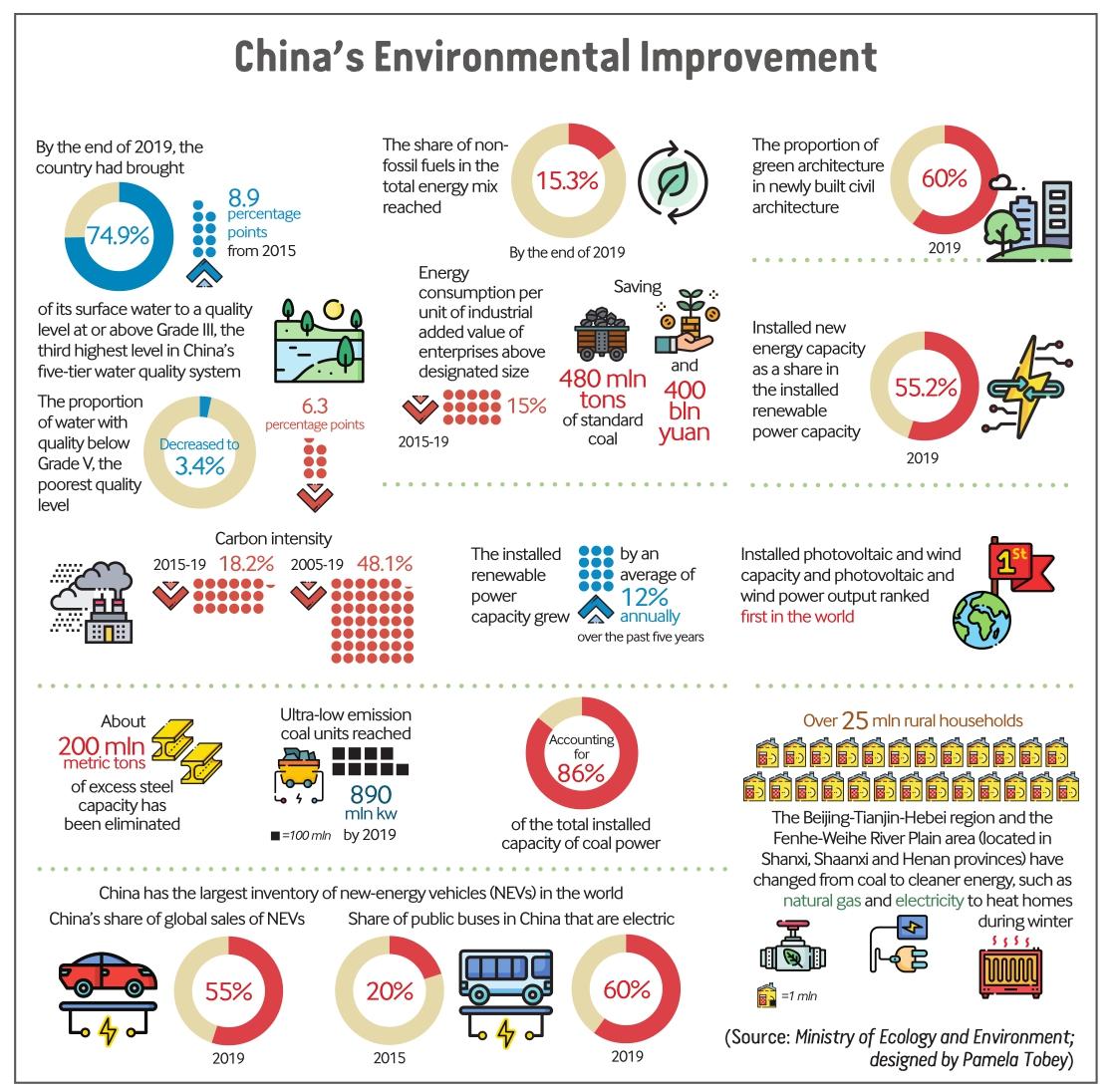The Green March
By Ji Jing

Although its autumn, the trees in the Yuquan Mountain Forest Park in Taiyuan, Shanxi Province in north China, are still green and the park is full of people taking a walk in the woods. The park is a green miracle created on a deserted mountain scarred by abandoned mines.
Shanxi is Chinas second largest coal producer after Inner Mongolia Autonomous Region, and its capital Taiyuan is at the heart of the coal-producing area. Ten years ago, the Yuquan Mountain, rich in coal, was covered by open coal pits and the area was choked by coal dust. When it rained, black water ran down the mountain, polluting the fi elds. The Yuquan had become a major source of pollution for the city.
In 2009, the local government decided to improve the area to make it suitable for living and drafted a plan to create 26 forest parks. Obsolete coal mines have been converted into parks under the ecological restoration drive.
In recent years, more coal mines have been shut down, which refl ects Chinas effort to become carbon neutral before 2060, as pledged by President Xi Jinping at the UN.
Green peaks
Private investors are encouraged to participate in ecological restoration. Zhang Junping, a retired soldier, decided to bid for greening the Yuquan Mountain. It was a surprise decision for him, who, having worked as a kettle man in the coal industry since he left the army, had no prior experience in afforestation.While Zhang was attracted by the new business opportunity, the people he hired quickly left after they saw the area he was trying to reclaim. It was a dismal place with over 100 disused quarries and nearly another 100 deserted coal and gypsum mines. Undeterred, Zhang continued to plant trees, hiring villagers to bring soil in buckets. Despite the efforts, after two years, the investment went down the drain as all the 120,000 trees he had planted died from drought.
Still undeterred, Zhang soldiered on. This time he built reservoirs on the mountain, a network of pipelines for irrigation and even a road to reach the slopes easily. He became known as the man who planted trees on the cliff.
After nearly nine years of toil and an investment of over 1 billion yuan ($149 million), the mountain today is covered with over 5 million trees in more than 100 varieties, becoming a verdant backyard of the city.
Chang Chunsheng, a local resident, told Xinhua News Agency that with the environment and transport improved, there are more opportunities for a better life. Many villagers have opened hostels and some have fruit orchards, creating a livelihood alternative to mining.
The transformations that have taken place in the Yuquan Mountain are seen in many other places across the country thanks to the measures implemented during the 13th Five-Year Plan (2016-20).
In Ningxia Hui Autonomous Region in northwest China, the Helan Mountains, another coal-rich region, have seen all coal mines shut down, and the ecology restored through afforestation. On another range, the Qinling Mountains in Shaanxi Province in northwest China, the houses built illegally on the slopes have been demolished.
At a press conference in October, Zhao Yingmin, Vice Minister of Ecology and Environment, said remarkable progress has been made in environmental protection in the past fi ve years, with the major targets and tasks set in the 13th Five-Year Plan mostly completed.
Eight of the nine pollution control goals, including reduction in carbon intensity and the discharge of fi ne particulate matters, sulfur dioxide, oxynitrides and ammoniacal nitrogen and improvement of surface and ground water quality, had been achieved by 2019. The remaining target, ensuring fairly good air quality in cities above prefectural level, is expected to be achieved by the end of this year.
Intensive efforts have been made across the country to control pollution. Fuling, a district in Chongqing Municipality in southwest China, is famous for its pickled vegetables, known as zhacai. However, in the past, a large amount of wastewater generated in the process was discharged without treatment into the Yangtze River that passes through the district.
To tackle the pollution, a wastewater treatment plant was built in 2008 to treat wastewater from the pickle factories. In addition, the 2,000 households who are involved in the zhacai industry were asked to build storage facilities for wastewater, which is later transport- ed to the treatment plant for safe disposal. The companies that buy pickles from these sellers bear the cost for transportation and treatment of the wastewater. There are also regular patrols to monitor the situation.
The fi ght against air pollution has also been successful in the past fi ve years. In the BeijingTianjin-Hebei region, dust per square kilometer was reduced by 7.5 tons last year; in the FenheWeihe River Plain that straddles Shanxi, Shaanxi and Henan provinces, it went down by 6 tons; and in the Yangtze River Delta Region, it was reduced by 4.4 tons.
To make pollution treatment more targeted, a leading group has been established to oversee air pollution prevention and treatment in the Beijing-Tianjin-Hebei region.
The energy structure nationwide has become more clean and low-carbon, with more new energy used. The industrial structure has been upgraded, with outdated capacity eliminated. The transportation system has become cleaner, with the proportion of railway transportation increased. Last year, the volume of goods transported by railway increased 7.2 percent year on year.
Mountains of gold
During the National Day holiday from October 1 to 8, Sanming, a city in Fujian Province in southeast China, received 4.22 million tourists, earning 2.5 billion yuan ($373 million) from tourism.This represents a green transformation of yet another industrial city. Since the 1950s, Sanming was a major industrial base for iron, coke, carbide, chemical fertilizers, cement and plastic products. But in recent years, it has shut down over 170 mines and established a law enforcement team to crack down on illegal mining.
Green industries such as tourism and healthcare are being developed in the city, while traditional industries are switching to clean production methods.
Zhao said over the past five years, the environmental protection awareness has improved. The saying by Xi that “lucid waters and lush mountains are invaluable assets” has been written into the Constitution of the Communist Party of China. More and more local governments are trying to strike a balance between economic development and environmental protection. Enterprises are aware of the need to control pollution as the laws have been tightened.
Zhao said China is also contributing its wisdom and solutions to global environmental governance. The government has met the carbon dioxide emission reduction target for 2020 ahead of schedule and has promised that the emissions will peak before 2030 and carbon neutrality will be achieved before 2060.
However, he also said the environmental quality still falls short of peoples aspirations for a better life and a beautiful China. The dominance of the heavy chemical industry, reliance on coal for energy, and dependence on road transport remain major challenges.
However, China had eliminated 280,000 tons of annual ozone depleting substance production capacity before 2018, according to Reuters, becoming one of the biggest contributors to protecting the ozone layer.
Also, under the Belt and Road Initiative an international green development coalition has been formed. It is undertaking cooperation projects to set up pilot low-carbon industrial parks in Cambodia, Laos, Kenya and other developing countries.

